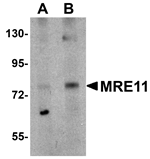MRE11 is involved in the repair of DNA double strand breaks as part of a complex that includes the Rad50 and NBS1 protein and is thought to act in the same pathway as the A-T mutated (ATM) protein. By itself, the protein has 3' to 5' exonuclease activity and endonuclease activity. The protein forms a complex with the RAD50 homolog; this complex is required for non-homologous joining of DNA ends and possesses increased single-stranded DNA endonuclease and 3' to 5' exonuclease activities. In conjunction with a DNA ligase, this protein promotes the joining of noncomplementary ends in vitro using short homologies near the ends of the DNA fragments. Mutations in this protein result in a novel ataxia telangiectasia-like disorder (ATLD). Unlike the ATM protein, MRE11 is necessary proper mammalian development.


